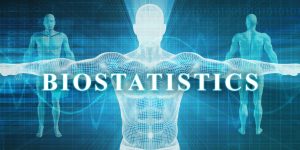Contents
Biostatistics, a specialized branch of statistics, plays a pivotal role in shaping our understanding of medicine, public health, biology, and environmental science. In this blog post, we unravel the significance of biostatistics, exploring its key applications in clinical trials, epidemiology, genetics, environmental health, and public health research. Whether you’re curious about the role of a biostatistician, the educational path to becoming one, or the diverse career paths within this field, join us on a journey to demystify the world of biostatistics and discover the impactful role it plays in advancing healthcare practices and scientific research.

What Is Biostatistics?
Biostatistics is a branch of statistics that deals with the collection, analysis, interpretation, and presentation of data in the context of biological and health sciences. It involves the application of statistical methods to design experiments, gather and analyze data, and draw conclusions in areas such as medicine, public health, biology, and environmental science.
Key areas of application for biostatistics include clinical trials, epidemiology, genetics, environmental health, and public health research. Biostatistical methods are employed to analyze data from experiments, observational studies, and surveys, contributing to advancements in medical science and healthcare practices.
What Does “Biostatistician” Mean?
A biostatistician is a professional who specializes in the application of statistical methods to the field of biology and health sciences. Biostatisticians work collaboratively with researchers, clinicians, and other professionals to design studies, collect data, and analyze information in order to draw meaningful conclusions and make evidence-based decisions. Their role is critical in ensuring that scientific research in the biological and health domains is conducted with rigor and precision.
Biostatistician Job Responsibilities
Biostatisticians play a crucial role in medical research and healthcare by helping researchers design experiments, choose appropriate sampling methods, and analyze data to make informed decisions. They use statistical techniques to identify patterns, relationships, and trends in data, helping researchers draw meaningful conclusions and make evidence-based recommendations.

Key responsibilities of biostatisticians include:
- Study Design: Biostatisticians help design experiments and research studies, determining the appropriate sample size, study duration, and data collection methods to ensure the statistical validity of the results.
- Data Collection and Management: They contribute to the planning and implementation of data collection procedures, ensuring that the data collected is accurate, reliable, and relevant to the research objectives.
- Statistical Analysis: Biostatisticians use a variety of statistical techniques to analyze data, identify patterns, assess relationships, and draw conclusions. This involves the application of methods such as hypothesis testing, regression analysis, survival analysis, and more.
- Interpretation and Reporting: They assist researchers in interpreting the statistical findings and communicate the results in a clear and meaningful way, often contributing to research papers, reports, and presentations.
- Consultation: Biostatisticians often serve as consultants, collaborating with researchers who may not have expertise in statistics. They provide guidance on study design, statistical methods, and data interpretation.
- Quality Assurance: Biostatisticians play a role in ensuring the quality and integrity of research studies by implementing rigorous statistical standards and addressing potential biases or confounding factors.
Biostatistician Educational Requirements
To become a biostatistician, individuals typically need a strong educational background in statistics, mathematics, or a related field, along with specialized training in biostatistics. The specific educational requirements can vary depending on the level of expertise and the desired career path.
- Bachelor’s Degree:
Obtain a bachelor’s degree in statistics, mathematics, biostatistics, or a closely related field. Courses in calculus, probability, and statistical methods are essential at this level.
Take courses that provide a foundation in statistical methods, data analysis, and mathematics. Biology and health science courses can also be beneficial.
- Research Experience
Participating in research projects or internships to gain hands-on experience in applying statistical methods to real-world problems can enhance your understanding of the field and make you more competitive for advanced programs.
- Master’s Degree (Optional, but Common) and Ph.D. (Optional for Advanced Roles):
While some entry-level positions may be available with a bachelor’s degree, many biostatisticians pursue a master’s degree in biostatistics or a related field for more advanced and specialized training.
For those seeking leadership roles, research positions, or academia, obtaining a Ph.D. in biostatistics or a related field may be necessary.
- Programming Skills:
Gain proficiency in statistical software and programming languages commonly used in biostatistics, such as R, Python, STATA, SAS, or SPSS.
Biostatistician Salary Range
The salary range for biostatisticians can vary based on factors such as education, experience, location, industry, and the specific responsibilities of the position. Generally, individuals with advanced degrees (such as a master’s or Ph.D.) and substantial experience tend to command higher salaries. The following figures provide a rough estimate of the salary range for biostatisticians:
- Entry-Level (Bachelor’s Degree):
- Entry-level biostatisticians with a bachelor’s degree may earn a starting salary in the range of $50,000 to $70,000 per year, depending on factors like location and industry.
- Mid-Level (Master’s Degree):
- Biostatisticians with a master’s degree and a few years of experience typically earn salaries in the range of $70,000 to $100,000 per year.
- Experienced (Ph.D. or Significant Experience):
- Those with a Ph.D. or extensive experience may earn salaries exceeding $100,000 per year. Salaries can range from $90,000 to $120,000 or more, depending on the individual’s expertise, leadership roles, and the demands of the position.
Career Paths in Biostatistics
Biostatisticians can work in various settings, including academic institutions, research organizations, pharmaceutical companies, healthcare agencies, and government institutions. Their work is essential in advancing scientific knowledge, particularly in areas such as clinical trials, epidemiology, genetics, and public health.
The field of biostatistics offers a diverse array of career paths, allowing professionals to contribute to scientific advancements, public health, and healthcare innovation in various capacities. The choice between academia and industry, coupled with the potential for specialization and career advancement, provides biostatisticians with a dynamic and fulfilling professional journey.
Academia vs. Industry
Biostatistics offers diverse and rewarding career paths, with professionals often choosing between academia and industry based on their interests and goals. In academia, biostatisticians engage in research, teach, and contribute to the academic community. They may collaborate with multidisciplinary teams, supervise graduate students, and publish research findings. Academic biostatisticians often work in universities, research institutions, or public health agencies, contributing to the advancement of statistical methods and knowledge in biological and health sciences.
On the other hand, industry positions in biostatistics are prevalent in pharmaceutical companies, healthcare organizations, and research and development institutions. Biostatisticians in industry play a crucial role in drug development, clinical trials, and epidemiological studies. They collaborate with scientists, clinicians, and regulatory agencies to ensure the validity and integrity of research outcomes. Industry professionals often work on diverse projects, applying statistical methods to address real-world challenges in healthcare and biological research.
Advancement Opportunities
Advancement opportunities in biostatistics are abundant, especially for those with advanced degrees and significant experience. Professionals can progress from entry-level roles to leadership positions, such as lead biostatistician, statistical team leader, or director of biostatistics. With leadership roles come increased responsibilities, including project management, team supervision, and strategic decision-making. Advancements may also involve specialization in a particular area of biostatistics, contributing to the growth and impact of the field.
Additionally, pursuing a Ph.D. in biostatistics opens doors to research-focused roles and academic positions. Those interested in shaping the future of statistical methodology or contributing to scientific knowledge may find satisfaction in research-oriented career paths within academia or research institutions.
Specialization Areas (Clinical Trials, Epidemiology, Genetics)
Biostatisticians often specialize in specific areas, aligning their expertise with the unique challenges of different fields. One prominent specialization is in clinical trials, where biostatisticians design study protocols, analyze trial data, and contribute to the regulatory approval process for new drugs and treatments. Their work ensures the reliability and validity of clinical trial results, ultimately impacting patient care and healthcare advancements.
Epidemiology is another specialization, where biostatisticians study the distribution and determinants of diseases in populations. They analyze data to identify patterns, risk factors, and trends, providing crucial insights for public health interventions and policy development.
In the realm of genetics, biostatisticians work with geneticists and researchers to analyze complex genetic data, identify genetic markers, and understand the genetic basis of diseases. Their contributions are fundamental in advancing our understanding of inherited conditions and developing personalized medicine approaches.
Top Companies For Biostatisticians
Several top companies and organizations hire biostatisticians to contribute to research, clinical trials, and data analysis in the field of biology and health sciences. The choice of top companies may vary based on individual preferences, career goals, and areas of interest within biostatistics.
Here are some notable companies and institutions known for employing biostatisticians:
- Pharmaceutical Companies:
- Pfizer
- Novartis
- Johnson & Johnson
- Roche
- Merck & Co.
- Contract Research Organizations (CROs):
- QuintilesIMS (now IQVIA)
- Parexel International
- Covance (a part of LabCorp)
- ICON plc
- Biotechnology Companies:
- Genentech
- Biogen
- Amgen
- Regeneron Pharmaceuticals
- Government Agencies:
- National Institutes of Health (NIH)
- Food and Drug Administration (FDA)
- Centers for Disease Control and Prevention (CDC)
- Academic and Research Institutions:
- Harvard T.H. Chan School of Public Health
- Johns Hopkins Bloomberg School of Public Health
- Fred Hutchinson Cancer Research Center
- Healthcare Organizations:
- Mayo Clinic
- Kaiser Permanente
- Cleveland Clinic
- Nonprofit Research Organizations:
- Dana-Farber Cancer Institute
- The Broad Institute
- Fred Hutchinson Cancer Research Center
You can have a broader list of biostatistician job opportunities if you make a search for biostatistician job opportunities on Indeed.

Leave a Reply